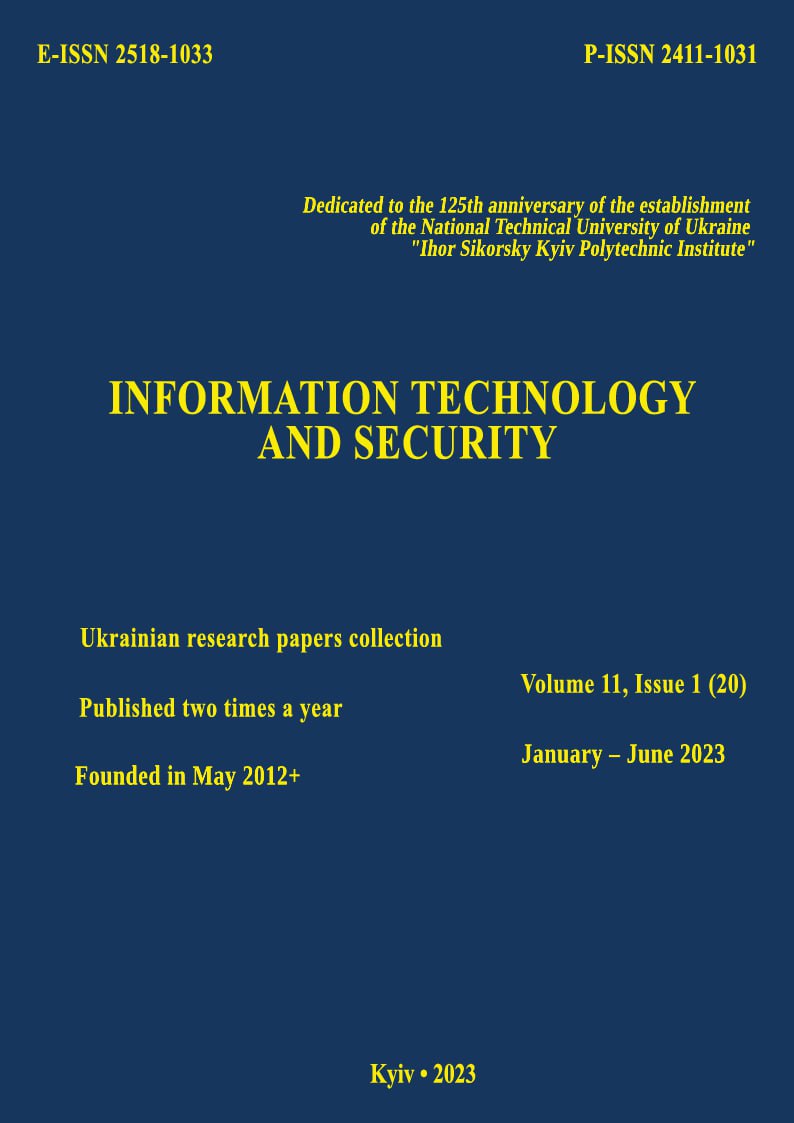Analytical model OFDM-MIMO signal in a radio channel with frequency-time selective fading
DOI:
https://doi.org/10.20535/2411-1031.2023.11.1.283538Keywords:
wireless electronic communication networks, inter-symbol interference, multi-antenna systems, orthogoal frequency multiplexing, fluctuation noiseAbstract
One of the main problems in modern wireless electronic communication networks is the transmission and reception of signals in multipath propagation. Due to the imperfect impulse response of the communication channel, frequency-selective fading of the transmitted signal occurs. This can cause waveform distortion and inter-symbol interference, which can seriously degrade the performance of the communication system. Thus, increasing the noise immunity of wireless electronic communication networks in real-world conditions is one of the most important tasks of modern communication technologies. Orthogonal frequency division multiplexing is known for its resistance to multipath fading and is used to reduce the impact of inter-symbol interference. Multi-antenna systems are a key technology for increasing bandwidth and improving communication reliability. The combination of these two technologies in wireless electronic communication networks can reduce the impact of negative phenomena on the transmitted signal in difficult interference conditions. An analytical model of the signal transmitted by a nonstationary frequency-selective radio channel in a wireless electronic communication network with orthogonal frequency multiplexing and a multi-antenna system is proposed. Analytical expressions are presented that allow us to jointly take into account the influence of interchannel and inter-symbol interference (the effect of multipath signal propagation and Doppler shift on the transmitted signal) against the background of fluctuating noise. Taking into account the factors affecting the transmitted signal makes it possible to bring the model closer to the real processes that occur in the vast majority of radio channels of wireless electronic communication networks.
References
Y. Wu, C. Xiao, Z. Ding, X. Gao, and S. Jin, “A survey on MIMO transmission with finite input signals: technical challenges, advances, and future trends”, Proceedings of the IEEE, vol. 10(106), pp. 1779-1833, 2018, doi: https://doi.org/10.1109/JPROC.2018.2848363.
C. N. Muoghalu, P. N. Achebe, and F. A Aigbodioh, “MIMO-OFDM techniques for wireless communication system: performance evaluation review”, International journal of advanced networking and applications, vol.14, pp. 5572-5581, doi: https://doi.org/10.35444/IJANA.2023.14410.
H. S. Hussein, M. Elsayed, U. S. Mohamed, H. Esmaiel, and E. M. Mohamed, “Spectral efficient spatial modulation techniques”, IEEE Access, vol. 7, pp. 1454-1469, 2019, doi: https://doi.org/10.1109/ACCESS.2018.2885826.
M. Marey, and H. Mostafa, “Second-order statistics for STBC classification over amplify-and-forward cooperative systems”, IEEE Access, vol. 11, pp. 21900-21911, 2023, doi: https://doi.org/10.1109/ACCESS.2023.3251219.
L. Imoize, A. Ibhaze, A. Atayero, and K. V. N. Kavitha, “Standard propagation channel models for MIMO communication systems”, Wireless Communications and Mobile Computing, vol. 2021, p. 36, 2021, doi: https://doi.org/10.1155/2021/8838792.
H. Kaur, M. Khosla, and R. K. Sarin, “Hybrid channel estimation for MIMO relay systems with Doppler offset influences, Int J Commun Syst. pp. 154-169, 2018, doi: https://doi.org/10.1002/dac.3469.
P. Srinu, R. K. Padma, and S. N. Bala, “Capacity and BER performance improvement in integrated MIMO-OFDM system using optimal power allocation, channel estimation, and turbo coding”, International Journal of Communication Systems, vol. 34, iss. 14, pp. 263-281, 2021, doi: https://doi.org/10.1002/dac.4915.
T. Chawla, and A. Kansal, “Intercarrier interference analysis for massive MIMO fractional Fourier transform-OFDM systems over time-varying channels”, International Journal of Communication Systems, vol. 33, iss. 16, pp. 323–341, 2020, doi: https://doi.org/10.1002/dac.4586.
P. Prajit, R. Bappadittya, and A. K. Bhattacharjee, “A novel Block Bi-diagonalization based pre-coding scheme for bit error reduction in mutiple input multiple output-orthogonal frequency division multiplexing”, Journal of Communication Systems, vol. 36, iss. 8, pp. 163–182, 2023, doi: https://doi.org/10.1002/dac.5469.
X. Li, H. Wang, N. Guan, and W. Lai, “A dual-mode index modulation scheme with Gray-coded pairwise index mapping”, IEEE Communications Letters, vol. 22, no. 8, 2018. pp. 1580-1583, doi: https://doi.org/10.1109/LCOMM.2018.2838582.
H. Singh, G. K. Soni, P. Suryawanshi, and G. Shankar, “Performance analysis and BER comparison of OFDM system for 4×4 MIMO fading channel in different modulation scheme”, in Proc. 3d International conference on smart systems and inventive technology (ICSSIT), Tirunelveli, India, 2020, pp. 255-259, doi: https://doi.org/10.1109/ICSSIT48917.2020.9214119.
L. Amhaimar, and A. E. Yaakoubi, “PAPR reduction of multi-antenna systems (MIMO-OFDM) using probabilistic algorithms”, in Proc. The 16th International conference interdisciplinarity in engineering, Târgu Mureș, Romania, 2022, pp.815-827, doi: https://doi.org/10.1007/978-3-031-22375-4_66.
T. Huynh-The, T.-V. Nguyen, Q.-V. Pham, D. B. Da Costa, and D.-S. Kim, “MIMO-OFDM modulation classification using three-dimensional convolutional network”, IEEE Transactions on Vehicular Technology, vol. 71, no. 6, 2023, pp. 6738-6743. doi: https://doi.org/10.1109/TVT.2022.3159254.
Downloads
Published
How to Cite
Issue
Section
License
Copyright (c) 2023 Collection "Information Technology and Security"

This work is licensed under a Creative Commons Attribution 4.0 International License.
The authors that are published in this collection, agree to the following terms:
- The authors reserve the right to authorship of their work and pass the collection right of first publication this work is licensed under the Creative Commons Attribution License, which allows others to freely distribute the published work with the obligatory reference to the authors of the original work and the first publication of the work in this collection.
- The authors have the right to conclude an agreement on exclusive distribution of the work in the form in which it was published this anthology (for example, to place the work in a digital repository institution or to publish in the structure of the monograph), provided that references to the first publication of the work in this collection.
- Policy of the journal allows and encourages the placement of authors on the Internet (for example, in storage facilities or on personal web sites) the manuscript of the work, prior to the submission of the manuscript to the editor, and during its editorial processing, as it contributes to productive scientific discussion and positive effect on the efficiency and dynamics of citations of published work (see The Effect of Open Access).

